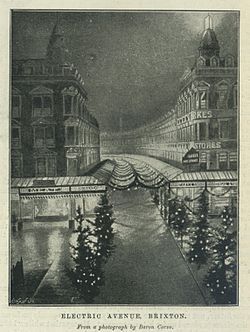
Electric Avenue is a street in Brixton, London. Built in the 1888,[1] it was the first market street to be lit by electric lights,[2][3] later, an iron and glass canopy was installed.[1] (On 3 February 1879, the first street to be lit by an incandescent lightbulb, invented by Joseph Swan, was Mosley Street, in Newcastle upon Tyne).[4] [5] [6] [7] Today, Electric Avenue contains national retail chains (Boots, Greggs, Iceland), various local food and housewares retailers, and hosts a part of Brixton Market (comprising the street market down Electric Avenue, Pope’s Road and Brixton Station Road, and the arcades of Brixton Village, Market Row and Reliance Arcade[8]), which specialises in selling African, Caribbean, South American and South Asian[9] products. It is located just around the corner from Brixton Underground station (1972). The street originally had cast iron Victorian canopies[10] over the pavements which were damaged in WWII, and removed in the 1980s.
